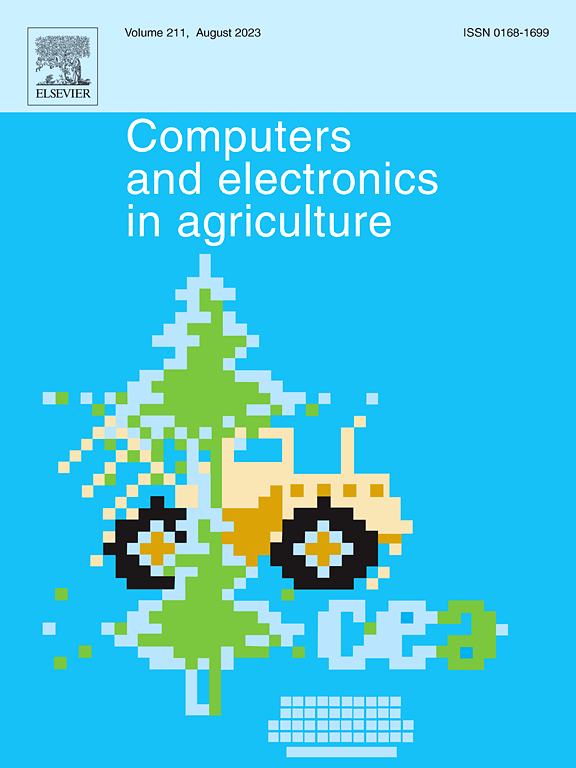MDS-PointPillars: A lightweight obstacle identification method in farmland based on three-dimensional LiDAR for autonomous navigation
IF 8.9
1区 农林科学
Q1 AGRICULTURE, MULTIDISCIPLINARY
引用次数: 0
Abstract
To improve the autonomous navigation and operation of smart agricultural machinery in complex farmland, this study proposes a lightweight obstacle identification method, MDS-PointPillars, based on three-dimensional LiDAR to enhance perception capabilities. The MDS-PointPillars model primarily consisted of two components: the pillar feature net (PFN) and the backbone. In the PFN component, a multi-pooling encoding module (MPE) was designed, which integrated max-pooling, average-pooling, and attention mechanisms to improve the extraction of multi-scale point cloud features. In the backbone component, a depthwise separable convolution block (DSB) was designed to reduce computational complexity while enhancing the perception of both local and global features. Additionally, the model incorporated a parameters-free simple attention module (SimAM), which adaptively strengthened the focus on key point cloud features, further improving the identification accuracy of rare and hard-to-classify obstacles. Experimental results showed that MDS-PointPillars achieved a mean average precision (mAP) of 90.8 % on the test set of person, agricultural machinery, and utility poles in farmland, with an inference speed of 20.1 FPS and a model size of only 13.1 MB, significantly reducing computational burden. Robustness test revealed that the MDS-PointPillars maintained precision (P), recall (R), and mAP above 88.4 %, 87.2 %, and 88.6 %, respectively, across different scenarios, demonstrating its excellent adaptability and robustness in complex agricultural environments. Compared with mainstream models, MDS-PointPillars reduces parameters by 91.1 %, 76.1 %, and 73.2 %, and improves speed by 645.5 %, 70.8 %, and 368.6 % compared to Pv-RCNN, SECOND, and PointRCNN, respectively. This highlights its greater application potential in resource-limited farmland.
基于三维激光雷达自主导航的农田轻型障碍物识别方法
为了提高复杂农田智能农机的自主导航和操作能力,本研究提出了一种基于三维激光雷达的轻型障碍物识别方法MDS-PointPillars,以增强感知能力。MDS-PointPillars模型主要由两部分组成:支柱特征网(PFN)和骨干。在PFN组件中,设计了多池编码模块(MPE),该模块集成了最大池化、平均池化和关注机制,提高了多尺度点云特征的提取效率。在主干组件中,设计了深度可分离卷积块(DSB),以降低计算复杂度,同时增强局部和全局特征的感知。此外,该模型引入了无参数的简单注意模块(SimAM),自适应加强了对关键点云特征的关注,进一步提高了对罕见和难以分类障碍物的识别精度。实验结果表明,MDS-PointPillars在农田人、农机、电线杆测试集上的平均精度(mAP)达到90.8%,推理速度为20.1 FPS,模型大小仅为13.1 MB,显著降低了计算负担。稳健性检验表明,MDS-PointPillars在不同情景下的精确度(P)、召回率(R)和mAP分别保持在88.4%、87.2%和88.6%以上,表明其在复杂农业环境下具有良好的适应性和稳健性。与主流模型相比,MDS-PointPillars分别减少了91.1%、76.1%和73.2%的参数,速度分别比Pv-RCNN、SECOND和PointRCNN提高了645.5%、70.8%和368.6%。这凸显了其在资源有限的农田中更大的应用潜力。
本文章由计算机程序翻译,如有差异,请以英文原文为准。
求助全文
约1分钟内获得全文
求助全文
来源期刊

Computers and Electronics in Agriculture
工程技术-计算机:跨学科应用
CiteScore
15.30
自引率
14.50%
发文量
800
审稿时长
62 days
期刊介绍:
Computers and Electronics in Agriculture provides international coverage of advancements in computer hardware, software, electronic instrumentation, and control systems applied to agricultural challenges. Encompassing agronomy, horticulture, forestry, aquaculture, and animal farming, the journal publishes original papers, reviews, and applications notes. It explores the use of computers and electronics in plant or animal agricultural production, covering topics like agricultural soils, water, pests, controlled environments, and waste. The scope extends to on-farm post-harvest operations and relevant technologies, including artificial intelligence, sensors, machine vision, robotics, networking, and simulation modeling. Its companion journal, Smart Agricultural Technology, continues the focus on smart applications in production agriculture.
 求助内容:
求助内容: 应助结果提醒方式:
应助结果提醒方式:


